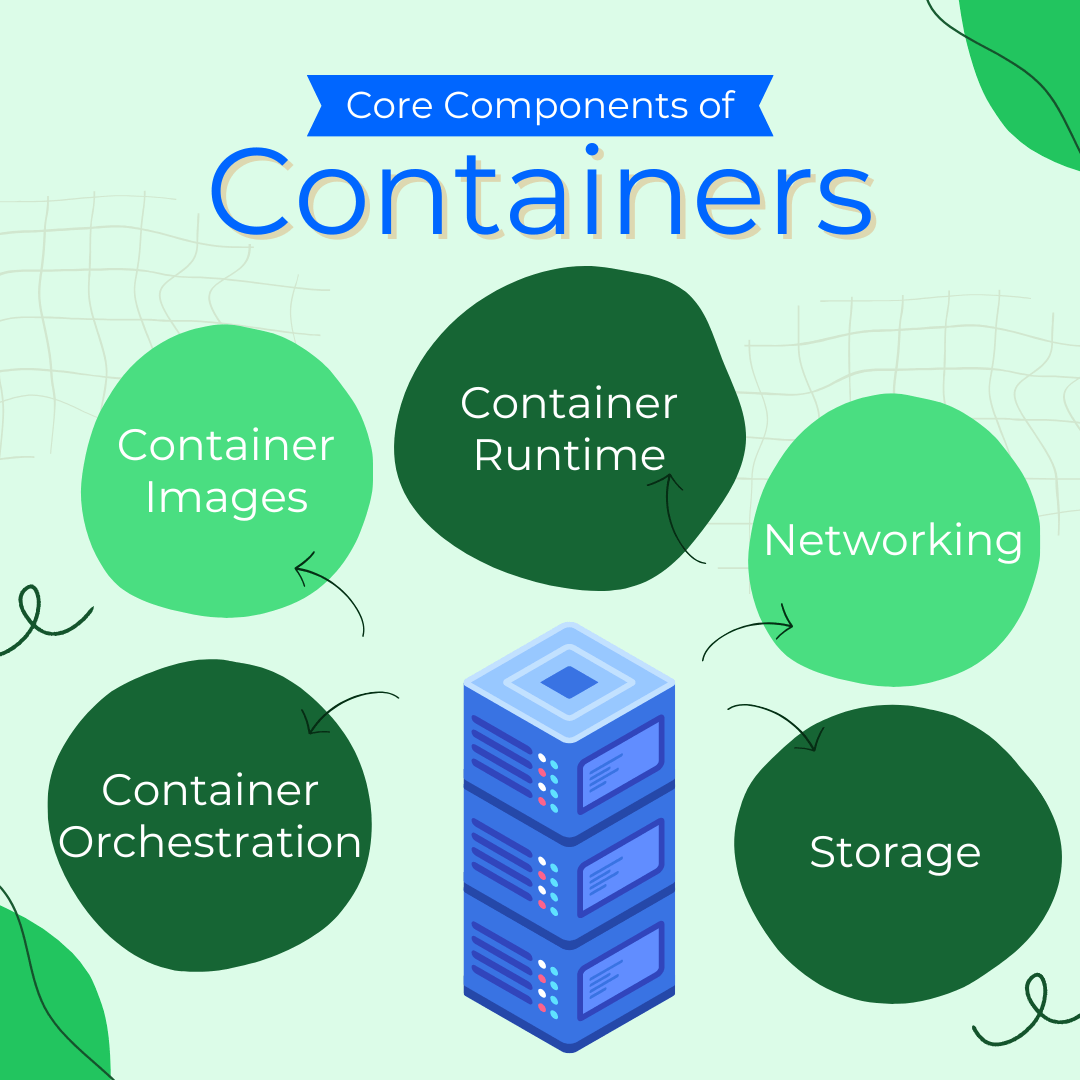Introduction
Managing application state can be complex and challenging. Stateful containers complicate data management with persistent storage needs, while stateless containers may struggle with maintaining context. This often leads to inefficiencies and operational issues.
Understanding the differences between stateful and stateless containers is crucial for optimizing performance and scalability. This article will clarify these concepts, helping you choose the right container type to meet your application's requirements and streamline your deployment strategy.
Understanding Containers
Containers provide a streamlined form of virtualization, encapsulating applications and their dependencies into a single, self-contained unit. This method ensures that applications function reliably across various computing environments, from development stages to production. Unlike traditional virtual machines (VMs), containers utilize the host system's operating system kernel, leading to lower overhead and enhanced performance.
Core Components of Containers
Container Images: These are the blueprints of containers, consisting of the application code, runtime, libraries, and settings. Container images are immutable, meaning they cannot be altered after they have been created. This immutability guarantees consistency and dependability across different environments.
Container Runtime: The container runtime is tasked with running and managing containers. It works with the operating system to allocate resources and ensure proper isolation for the container. Well-known container runtimes include Docker Engine and containerd, which are commonly used to manage and execute containers.
Container Orchestration: Orchestration tools manage the deployment, scaling, and operation of containerized applications. Kubernetes and Docker Swarm are prominent examples, enabling automated handling of container clusters and ensuring high availability and efficient resource utilization.
Networking: Networking in containers enables communication between containers, across hosts, and with external systems. It involves different types of networking modes such as bridge, host, and overlay, each suited to specific scenarios. Networking ensures that containers can interact with each other and connect to resources, maintaining smooth functionality in multi-container applications.
Storage: Containers require persistent storage solutions to retain data beyond the lifecycle of individual containers. Storage options include volumes, bind mounts, and third-party storage plugins, providing flexibility in managing data persistence and access. This persistence is essential for applications that require reliable data storage even when containers are restarted or scaled across nodes.
Containers simplify the deployment process by encapsulating applications in a portable format that includes everything needed for consistent performance across environments. They allow developers to build, test, and deploy applications confidently, knowing the container will behave consistently. Core components like networking and storage further ensure seamless communication and data persistence across instances. This consistency is a key advantage over traditional VMs, which require a full OS for each instance and can be more resource-intensive.

Stateful Containers
Stateful containers maintain and manage data over time, ensuring that an application’s state persists even after restarts or crashes. Unlike stateless containers, which do not retain information between requests, stateful containers are designed to handle data persistence and continuity, making them crucial for applications that require reliable storage and state management.
Definition and Characteristics
Stateful containers are built to manage and retain data across different instances. They maintain application state within the container itself or through external storage solutions, allowing them to recover and continue from where they left off. Key characteristics include the ability to persist data, manage connections, and ensure that stateful operations can continue seamlessly despite disruptions.
Use Cases for Stateful Containers
Stateful containers are ideal for applications that need to keep track of ongoing data or transactions. Common examples include databases (like MySQL or MongoDB), caching systems (such as Redis), and message brokers (e.g., RabbitMQ).
These applications rely on persistent storage to function correctly and deliver consistent user experiences. While stateful containers offer critical benefits, they also come with challenges such as managing data backups, ensuring high availability, and handling data consistency.
Popular Stateful Container Technologies
In Kubernetes, StatefulSets play a crucial role in managing stateful applications. StatefulSets provide stable, unique network identifiers and persistent storage for each container instance, enabling applications to maintain their state across restarts and scaling operations.
Other technologies, like Docker’s volume management, also support stateful container deployments by providing mechanisms to manage persistent data.
Stateless Containers
Stateless containers operate without retaining any data between requests, which simplifies scaling and deployment. They handle each request independently, without relying on prior interactions or stored information. This approach is particularly suited for applications where each request is self-contained and does not require historical context.
Definition and Characteristics
Stateless containers are designed to manage tasks without maintaining any internal state. This means that any data required for processing a request must be provided within that request or retrieved from an external service. The primary characteristic of stateless containers is their ability to be easily replicated and scaled horizontally since there is no dependency on local data storage or previous interactions.
Use Cases for Stateless Containers
Stateless containers are ideal for applications where each operation is independent and does not rely on stored state. Examples include web servers, RESTful APIs, and microservices that process user requests or data streams without needing to remember past transactions.
These containers can quickly adapt to changing workloads, making them suitable for applications with variable or high traffic volumes. Their simplicity and scalability come with advantages such as easier management and better fault tolerance, but they may face challenges in handling applications that require context or session management.
Popular Stateless Container Technologies
In Kubernetes, Deployments are designed to manage and orchestrate stateless applications. They provide mechanisms for scaling and updating containers without affecting the overall application state. Other technologies, such as Docker’s Swarm mode, also support the deployment and management of stateless containers, allowing for streamlined operations and scalability.
Stateless containers offer a robust solution for modern applications that need to handle fluctuating loads and scale efficiently, while minimizing complexity and overhead in managing application state.
Comparing Stateful and Stateless Containers
When choosing between stateful and stateless containers, it’s essential to understand their key differences and how these affect application performance and scalability. Each type serves distinct purposes and is suited to different application needs, making it crucial to match the container type with your specific requirements.
Key Differences
The primary distinction between stateful and stateless containers lies in how they manage data. Stateful containers retain information across different instances and requests, ensuring that data is preserved and accessible even after restarts or failures.
This is vital for applications that require continuous data handling, like databases or messaging systems. In contrast, stateless containers do not retain any data between requests. They process each request independently, relying on external services or storage solutions to manage state.
Performance Implications
Stateful containers often involve more complex management due to their need to handle persistent storage and data recovery. This can impact performance, especially when scaling, as ensuring data consistency and availability becomes more challenging.
Stateless containers, on the other hand, are generally more straightforward to scale and manage because they do not depend on internal state. This simplicity allows for more efficient horizontal scaling and better fault tolerance, but may not be suitable for applications requiring historical context or session data.
When to Use Each Type
Stateful containers are ideal for applications with specific data requirements or those that need to maintain user sessions and transaction histories. They are best used in scenarios where data consistency and persistence are critical.
Stateless containers are preferable for applications that need to handle high traffic loads with minimal complexity, such as web servers and microservices. They offer flexibility and scalability, making them suitable for dynamic and variable workloads.
Choosing the right type of container involves evaluating your application's data management needs and operational requirements. By understanding the strengths and limitations of each container type, you can make an informed decision that aligns with your application’s goals and performance expectations.
Implementation Strategies
Successfully deploying stateful and stateless containers requires tailored strategies to ensure optimal performance, reliability, and scalability. Each type of container comes with its own set of best practices to address its unique characteristics and operational needs.
Best Practices for Stateful Containers
- Data Persistence and Management: For stateful containers, ensuring data persistence is crucial. Use persistent volumes or storage solutions to keep data consistent across container restarts and failures. Tools like Kubernetes Persistent Volumes (PVs) and StatefulSets help manage storage and maintain data integrity.
- Backup and Recovery: Regularly back up data and implement recovery strategies to handle data loss or corruption. Automated backup solutions can simplify this process, providing safety nets for critical information.
- High Availability: Implement redundancy and failover mechanisms to ensure continuous availability of stateful services. Distribute data across multiple nodes or replicas to minimize downtime and prevent single points of failure.
Best Practices for Stateless Containers
- Scaling and Load Balancing: Stateless containers can be easily scaled horizontally. Use load balancers to distribute traffic evenly across multiple instances, ensuring efficient resource utilization and improved performance.
- Fault Tolerance: Since stateless containers do not maintain internal state, failures in individual instances can be handled by spinning up new containers. Ensure that your orchestration tools are configured to automatically replace or scale containers based on demand.
- Configuration Management: Externalize configuration and state management using environment variables or configuration management systems. This approach allows containers to remain stateless while still being able to adapt to different environments and configurations.
Hybrid Approaches
Combining stateful and stateless containers can address various application needs within a single system. For example, you might use stateless containers for front-end services and stateful containers for back-end databases. This hybrid approach leverages the strengths of both container types, optimizing performance and data management.
Case Studies and Real-Life Examples
Examining real-world applications of stateful and stateless containers can illuminate their practical advantages and challenges. Here are two detailed case studies highlighting their use:
Case Study 1: Stateful Containers in Action
Company: Spotify
Challenge: Spotify required a solution for managing its massive, constantly changing user data across various services. The challenge was to ensure data consistency and high availability for its recommendation engine and user profiles.
Solution: Spotify utilized Kubernetes StatefulSets for their stateful components. This setup allowed them to maintain stable network identities and persistent volumes for their databases and caches. By employing stateful containers, Spotify could manage data across multiple instances, ensuring high availability and resilience.
Outcome: The implementation of StatefulSets enabled Spotify to handle large volumes of user data efficiently. The company achieved improved data consistency and fault tolerance, contributing to a better user experience with reliable recommendations and seamless service continuity.
Case Study 2: Stateless Containers in Action
Company: Netflix
Challenge: Netflix needed a scalable solution to manage its dynamic content delivery and streaming services. The challenge was to handle high traffic loads and frequent updates without impacting performance.
Solution: Netflix adopted stateless containers for its content delivery and microservices architecture. By using Docker and Kubernetes, Netflix could scale its services horizontally, deploying new instances as needed without worrying about state management.
Outcome: Netflix experienced significant improvements in scalability and fault tolerance. Stateless containers allowed Netflix to efficiently handle fluctuating demand and rapidly deploy updates, contributing to a seamless streaming experience for millions of users globally.
Tools and Technologies
Leveraging the right tools and technologies is crucial for effectively managing stateful and stateless containers. These tools facilitate deployment, orchestration, and monitoring, ensuring smooth and efficient operations.
Container Orchestration Platforms
Kubernetes: Kubernetes is the leading container orchestration platform, known for its robust features and scalability. It supports both stateful and stateless container management through resources like StatefulSets for stateful applications and Deployments for stateless ones. Kubernetes provides automated deployment, scaling, and management, making it a comprehensive solution for containerized applications.
Docker Swarm: Docker Swarm is another orchestration tool that simplifies container management. While not as feature-rich as Kubernetes, it offers built-in clustering and load balancing for stateless containers. Swarm’s straightforward setup and integration with Docker make it suitable for smaller-scale deployments.
Container Management Tools
Docker: Docker is the most widely used platform for creating and managing container images. It offers tools for creating, running, and distributing containers. Docker’s CLI and Docker Compose simplify the development and deployment of both stateful and stateless containers.
Podman: Podman is an alternative to Docker, offering similar functionality for container management without requiring a daemon. It supports both stateful and stateless container operations and is known for its compatibility with Docker commands.
Monitoring and Logging
Prometheus and Grafana: Prometheus, paired with Grafana, provides powerful monitoring and visualization capabilities for containerized applications. Prometheus collects metrics from containers, while Grafana offers real-time dashboards to track performance and resource usage.
ELK Stack (Elasticsearch, Logstash, Kibana): The ELK Stack is a popular solution for logging and analyzing container logs. Elasticsearch indexes logs, Logstash processes and transports them, and Kibana provides visualization tools for monitoring and troubleshooting.
Key Takeaways
- Stateful vs. Stateless Containers: Stateful containers manage and persist data across instances, while stateless containers handle requests independently, simplifying scaling and fault tolerance.
- Choosing the Right Container: Use stateful containers for applications requiring data consistency and persistence (e.g., databases), and stateless containers for scalable, high-traffic services (e.g., web servers).
- Best Practices: For stateful containers, focus on data persistence, backup, and high availability. For stateless containers, prioritize scalability, load balancing, and configuration management.
- Real-World Applications: Companies like Spotify and Netflix effectively use stateful and stateless containers, respectively, to manage data consistency and scalability challenges.
- Essential Tools: Utilize orchestration platforms like Kubernetes or Docker Swarm, management tools like Docker or Podman, and monitoring solutions like Prometheus, Grafana, or the ELK Stack for efficient container management.
Conclusion
Understanding whether to use stateful or stateless containers is key to optimizing application deployment. Stateful containers are essential for applications needing data persistence, while stateless containers excel in scalability and flexibility.
Choosing the right type based on your application’s requirements can enhance performance and efficiency. Utilizing tools like Kubernetes and Docker Swarm, along with effective monitoring solutions, will ensure robust and efficient container management, aligning with your specific operational needs.

